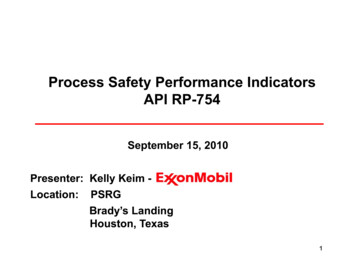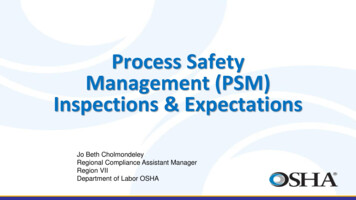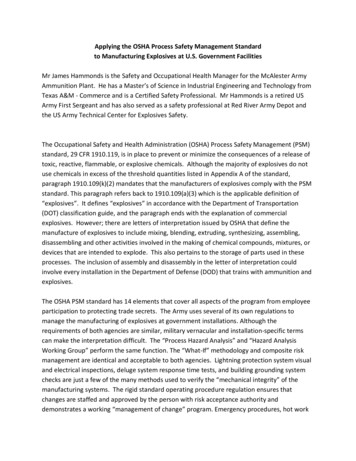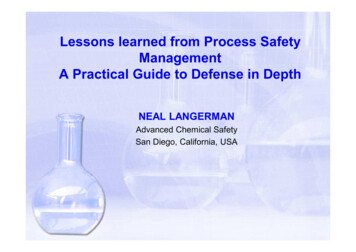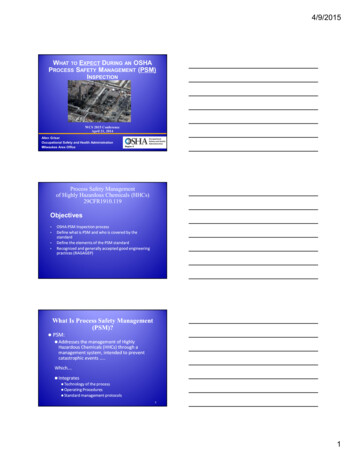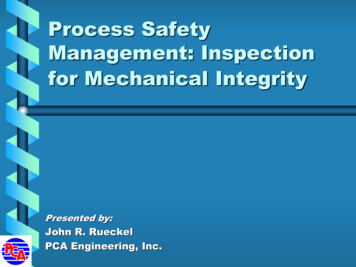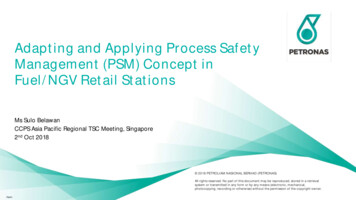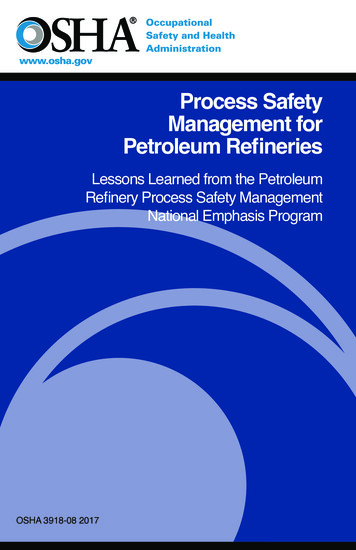
Transcription
Process SafetyManagement forStorage FacilitiesOSHA 3909-03 2017
Occupational Safety and Health Act of 1970“To assure safe and healthful working conditionsfor working men and women; by authorizingenforcement of the standards developed underthe Act; by assisting and encouraging the Statesin their efforts to assure safe and healthfulworking conditions; by providing for research,information, education, and training in the field ofoccupational safety and health.”This guidance document is not a standardor regulation, and it creates no new legalobligations. It contains recommendations as wellas descriptions of mandatory safety and healthstandards. The recommendations are advisoryin nature, informational in content, and areintended to assist employers in providing a safeand healthful workplace. The Occupational Safetyand Health Act requires employers to complywith safety and health standards and regulationspromulgated by OSHA or by a state with anOSHA‑approved state plan. In addition, the Act’sGeneral Duty Clause, Section 5(a)(1), requiresemployers to provide their employees with aworkplace free from recognized hazards likely tocause death or serious physical harm.Material contained in this publication is in thepublic domain and may be reproduced, fully orpartially, without permission. Source credit isrequested but not required.This information will be made available tosensory-impaired individuals upon request.Voice phone: (202) 693-1999; teletypewriter(TTY) number: 1-877-889-5627.
Process Safety Managementfor Storage FacilitiesU.S. Department of LaborOccupational Safety and Health AdministrationOSHA 3909-03 2017
ContentsPurpose . . . . . . . . . . . . . . . . . . . . . . . . . . . . . . . . . . . . . . . . . . . . . . . 1Applicability . . . . . . . . . . . . . . . . . . . . . . . . . . . . . . . . . . . . . . . . . . . 4Employee Participation. . . . . . . . . . . . . . . . . . . . . . . . . . . . . . . . . . 6Process Safety Information . . . . . . . . . . . . . . . . . . . . . . . . . . . . . . 6Information on Highly Hazardous Chemicals . . . . . . . . . . . . . . 7Information on Process Technology . . . . . . . . . . . . . . . . . . . . . 7Information on the Process Equipment . . . . . . . . . . . . . . . . . . . 8Process Hazard Analysis (PHA) . . . . . . . . . . . . . . . . . . . . . . . . . . . 9Operating Procedures. . . . . . . . . . . . . . . . . . . . . . . . . . . . . . . . . . 11Training . . . . . . . . . . . . . . . . . . . . . . . . . . . . . . . . . . . . . . . . . . . . . . 12Mechanical Integrity . . . . . . . . . . . . . . . . . . . . . . . . . . . . . . . . . . . 13Emergency Planning and Response . . . . . . . . . . . . . . . . . . . . . . 15APPENDIX: Misconceptions andFrequently Asked Questions . . . . . . . . . . . . . . . . . . . . . . . . . . . . 17Workers’ Rights . . . . . . . . . . . . . . . . . . . . . . . . . . . . . . . . . . . . . . . 21OSHA Assistance, Services and Programs . . . . . . . . . . . . . . . . 21Establishing a Safety and Health Program . . . . . . . . . . . . . . . 21Compliance Assistance Specialists . . . . . . . . . . . . . . . . . . . . . 21Free On-site Safety and Health Consultation Servicesfor Small Business. . . . . . . . . . . . . . . . . . . . . . . . . . . . . . . . . . . 21Cooperative Programs. . . . . . . . . . . . . . . . . . . . . . . . . . . . . . . 22Occupational Safety and Health Training Courses. . . . . . . . 23OSHA Educational Materials. . . . . . . . . . . . . . . . . . . . . . . . . . 23OSHA Regional Offices. . . . . . . . . . . . . . . . . . . . . . . . . . . . . . . . . 24How to Contact OSHA. . . . . . . . . . . . . . . . . . . . . . . . . . . . . . . . . 27
PurposeThis document does not cover the entire Process SafetyManagement (PSM) standard, but only focuses on aspects ofthe standard particularly relevant to storage facilities. For afull compliance guide to PSM, please refer to OSHA 31321 orthe full text of the standard at www.osha.gov.2 Although allelements of the PSM standard apply to a PSM-covered storagefacility, the following elements of the standard are mostrelevant to hazards associated with storage facilities: Employee Participation Process Safety Information (PSI) Process Hazard Analysis Operating Procedures Training Mechanical Integrity (MI) Emergency Planning and ResponsePSM is critically important to facilities that store highlyhazardous chemicals. Implementing the required safetyprograms help prevent fires, explosions, large chemical spills,toxic gas releases, runaway chemical reactions, and othermajor incidents. This will ensure that employees, contractors,facility visitors and emergency responders are safe from thesehazards. Compliance will also benefit employers by minimizingdamage to facility equipment and neighboring structures in theevent of an HHC release.Between 1997 and 2013, there have been numerous incidentsat storage facilities that have caused serious injuries andfatalities to employees. Several examples are included below: In 2013, a facility that stored and distributed compressedpropane gas was largely destroyed by a series of fires andexplosions. After receiving spent propane gas cylinders,employees would “bleed” any remaining gas into the air1. www.osha.gov/Publications/osha3132.pdf2. www.osha.gov/pls/oshaweb/owadisp.show document?p table STANDARDS&p id 9760PROCESS SAFETY MANAGEMENT FOR STORAGE FACILITIES1
before the cylinders were cleaned and reused. On thenight of the incident, investigators believe, this practiceresulted in a cloud of flammable propane gas at the facility,which was ignited by a spark from a forklift operating inthe area. The resulting explosions and fires injured severalemployees—four critically. In 2008, a nearly 90-year-old storage tank catastrophicallyfailed and released approximately 2.1 million gallons ofliquid fertilizer. The collapsing tank seriously injured twoemployees, and the chemicals flowed over containmentberms. Investigators determined that defective welds likelycaused the tank failure, and inspectors condemned anothertank at the same facility that presented an “imminentdanger” of failure. Major contributing factors were theinadequacy of tank weld inspections and overestimatesof the maximum liquid levels that the tank could safelyaccommodate. Further, some tank inspection and testingactivities did not follow recognized and generally acceptedgood engineering practices. This is a recurring categoryof incident: between 1995 and 2008, 16 tanks at otherfacilities catastrophically failed, killing one employee andhospitalizing four others. Faulty welding caused 11 of thesetank failures (CSB, 2009). In 2005, a fire and subsequent explosion(s) destroyed afacility that stored and distributed compressed gas, andpropelled debris and projectiles. The incident was tracedback to propylene gas cylinders in the facility’s storage areathat were directly exposed to sunlight. High temperaturesfrom the sunlight exposure increased cylinder pressureenough to cause flammable vapors to leak from thecylinders and catch fire. Heat from the initial fire causedother cylinders to leak gas. The fire spread throughoutthe storage area and eventually consumed nearly 8,000cylinders of compressed gas. In 2003, an industrial facility that stores and distributeschlorine received a routine railcar shipment of liquidchlorine. The chlorine was transferred to a bulk trailer,a procedure that the facility had conducted for manyOCCUPATIONAL SAFETY AND HEALTH ADMINISTRATION2
years without serious incident. The loading process wasequipped with a scrubber, which was designed to controlchlorine vapors displaced during trailer filling. On the day ofthe incident, chlorine vapors overwhelmed the scrubbers’capacity, and up to 1,920 pounds of chlorine escapedinto the air. This incident occurred in a process for whicha process hazard analysis had already been conducted.However, investigators found that the process hazardanalysis failed to consider the consequences of chlorinegases overloading the scrubbers (CSB, 2007). In 1999, a truck driver was killed and an employee injuredwhen a chemical shipment was inadvertently loaded intothe wrong tank. Due to this error, incompatible chemicalscame into contact, reacted, and released a cloud of toxicgas containing lethal levels of hydrogen sulfide. In this case,the employer’s failure to have adequate process safetyinformation on chemical incompatibilities, its inadequatechemical unloading procedures, and its failure to implementappropriate controls all contributed to the incident (NTSB,2001). Other similar incidents have been recorded. A1998 incident investigated by the National TransportationSafety Board (NTSB) occurred when inadvertent mixing ofincompatible chemicals at a facility’s loading dock releasedtoxic gases. That incident injured seven people—includingtwo first responders—and caused 3,000 workers to beevacuated or instructed to shelter in place (NTSB, 2000). In 1997, three firefighters were killed by flying debris froman explosion in the storage area of a pesticide distributionfacility. Investigators concluded that the explosion was mostlikely caused by a sack of thermally unstable material thathad been placed too close to a hot compressor dischargepipe. The heat from the pipe caused the material todecompose and release flammable vapors, which eventuallyignited and exploded. The investigators recommended thatsafety programs to review hazards should be implementedat all facilities that store, manufacture, handle, or usehazardous chemicals (EPA 1999).PROCESS SAFETY MANAGEMENT FOR STORAGE FACILITIES3
ApplicabilityThe Process Safety Management standard covers processeswhich involve a chemical at or above the specified thresholdquantity (TQ) listed in Appendix A of the PSM standard3,unless another Federal Agency has jurisdiction.4 The PSMstandard is also applicable to processes containing aCategory 1 flammable gas (as defined in 1910.1200(c)) or aflammable liquid with a flashpoint below 100 F (37.8 C) onsite in one location, in a quantity of 10,000 pounds (4535.9 kg)or more. A “process” is defined by OSHA in the PSM standardas “any activity involving a highly hazardous chemicalincluding any use, storage, manufacturing, handling, or theon-site movement of such chemicals, or combination of theseactivities.”5 The standard also states that any group of vesselswhich are interconnected and separate vessels that are locatedsuch that a highly hazardous chemical could be involved in apotential release, shall be considered a single process.The following operations are excepted from the PSMstandard’s scope, which may apply to some storage facilities: Retail facilities Hydrocarbon fuels used solely for workplace consumptionas a fuel (e.g., propane used for comfort heating, gasolinefor vehicle refueling), if such fuels are not a part of aprocess containing another highly hazardous chemical(HHC) covered by the PSM standard Flammable liquids with a flashpoint below 100 F (37.8 C)stored in atmospheric tanks or transferred which are keptbelow their normal boiling point without benefit of chillingor refrigeration. (Note: Atmospheric tanks are storagetanks designed to operate at pressures from atmosphericthrough 0.5 psig)3. Calculation of TQ for mixtures is explained in an OSHA Letter of Interpretation at www.osha.gov/pls/oshaweb/owadisp.show document?p table INTERPRETATIONS&p id 308484. Section 4(b)(1) of the OSH Act, 29 U.S.C. 653(b)(1), provides that OSHA has no authority to regulatea working condition if another federal agency exercises statutory authority to prescribe or enforcea standard or regulation addressing that working condition. Thus, except as noted, if anotherfederal agency has or enforces a standard or regulation addressing accidental releases of regulatedsubstances, the OSH Act does not apply to that working condition.5. 29 CFR 1910.119.OCCUPATIONAL SAFETY AND HEALTH ADMINISTRATION4
Oil or gas well drilling or servicing operations6 Normally unoccupied remote facilities7All storage facilities that do not fit under one of theseexemptions should determine whether they fall under theOSHA PSM standard and comply with the standard if they do.Storage facilities typically have considerably less complexprocess safety issues than facilities with large chemicalmanufacturing operations, which may make compliance easierand less costly. Some organizations and trade associationsprovide PSM compliance resources for their members. Those thatmay address storage activities include, but are not limited to: Insurance companies Local fire officials National Association of Chemical Distributors (NACD) Center for Chemical Process Safety (CCPS) Agricultural Retailers Association (ARA) American Chemistry Council (ACC) Society of Chemical Manufacturers and Affiliates (SOCMA) American Petroleum Institute (API) The Fertilizer Institute (TFI) Compressed Gas Association (CGA) National Fire Protection Association (NFPA) International Warehouse Logistics Association (IWLA)Small businesses may contact OSHA’s free On-siteConsultation Program for help with identifying and mitigatingworkplace hazards. OSHA’s On-site Consultation Programoffers free and confidential occupational safety and healthservices to small and medium-sized businesses in all statesand several territories, with priority given to high-hazardworksites. On-site Consultation services are separate fromenforcement and do not result in penalties or citations.6. Letter of Interpretation: www.osha.gov/pls/oshaweb/owadisp.show document?ptable INTERPRETATIONS&p id 237277. Letter of Interpretation: www.osha.gov/pls/oshaweb/owadisp.show document?ptable INTERPRETATIONS&p id 22592PROCESS SAFETY MANAGEMENT FOR STORAGE FACILITIES5
Consultants from state agencies or universities work withemployers to identify workplace hazards, provide advice oncompliance with OSHA standards, and assist in establishingand improving safety and health programs. To locate theOSHA On-site Consultation Program nearest you, call 1-800321-6742 (OSHA) or visit www.osha.gov/consultation.Although all elements of the PSM standard apply to aPSM‑covered storage facility, the following elements of thePSM standard are particularly relevant to hazards associatedwith storage facilities:Employee ParticipationEmployees with experience in hazard identification andprevention are vital to workplace safety. Workplace safetyis taken seriously if employees are committed to followinghealth and safety procedures and have a sincere interest indeveloping them.The PSM standard requires that employers covered underthe standard: Develop a written plan of action regarding how they willimplement employee participation. Consult their employees and their representatives regardingconducting and developing process hazard analysis (PHAs)and other elements of process safety management. Ensure that their employees and their representatives haveaccess to PHAs and all other information required to bedeveloped by the PSM standard.Process Safety InformationEmployers are required to compile written process safetyinformation (PSI). The compilation of written process safetyinformation will help the employer and the workers involved inoperating the process to identify and understand the hazardsOCCUPATIONAL SAFETY AND HEALTH ADMINISTRATION6
involved in their processes. Process safety information mustinclude information on the hazards of the highly hazardouschemicals used or produced by the process, informationon the technology of the process, and information on theequipment used in the process. Process safety informationfor the storage of highly hazardous chemicals will usuallybe considerably less extensive than that required for themanufacture or use of such chemicals.Information on Highly Hazardous ChemicalsFor every highly hazardous chemical, PSM requires thatemployers compile information on chemical toxicity, permissibleexposure limits, physical data, reactivity data, corrosivity data,thermal and chemical stability data, and hazardous effectsassociated with inadvertent mixing of chemicals that mayoccur. Facilities are required by OSHA’s Hazard Communicationstandard to have Safety Data Sheets (SDSs) for hazardouschemicals in their workplaces, which often contain some of thisinformation. If an employer does not already have an SDS, itmust obtain it from its chemical suppliers.Storage facilities should be aware of reactivity hazardsincluding unstable substances or incompatibility issues. TheCenter for Chemical Process Safety (CCPS) provides basicguidance on chemical reactivity, which facilities can consult onthe CCPS webpage.8The NOAA/EPA/CCPS Chemical Reactivity Worksheet9 is availableto aid in identifying potentially incompatible chemicals.Information on Process TechnologyProcess technology is likely much less complicated whenthe employer only stores chemicals, rather than processing,mixing, or deliberately reacting them.8. l-hazards9. orksheet-40PROCESS SAFETY MANAGEMENT FOR STORAGE FACILITIES7
Process technology information must include: Diagrams (Block, Process Flow) – an example of which isshown in non-mandatory Appendix B of the PSM standard, Maximum inventory levels for all chemicals in the PSMcovered process, Safe upper and lower process limits for such items astemperatures, pressures, flows or compositions, and An evaluation of the consequences of deviation, includingthose affecting the safety and health of employees, thatcould occur if operating beyond the established processlimits.Information on the Process EquipmentMany storage facilities may have minimal process equipment.Nevertheless, facilities must collect information on equipmentthat is part of the PSM-covered process. Typical equipmentmay include: storage tanks, piping, pumps, containers,pressure relief systems, dikes, ventilation equipment, alarms,controls, process safeguards and monitoring equipment.Employers are required to collect equipment information onmaterials of construction, piping and instrument diagrams(P&IDs), electrical classifications, relief system designand design basis, ventilation system designs, and safetysystems. For facilities using packaged storage systems, themanufacturer will provide most, if not all, of this information.Facilities without piping such as those that store small containersonly, typically will not have P&IDs. Questions on applicability ofspecific PSM requirements pertaining to unique situations shouldbe referred to OSHA’s Directorate of Enforcement Programs orthe appropriate OSHA Consultation Program Office.Employers must document that all equipment complies withrecognized and generally accepted good engineering practices(RAGAGEP). OSHA has published guidance10 clarifying10. www.osha.gov/pls/oshaweb/owadisp.show document?p table INTERPRETATIONS&p id 30785OCCUPATIONAL SAFETY AND HEALTH ADMINISTRATION8
RAGAGEP requirements and identifying potential sources ofRAGAGEP. In all cases, the RAGAGEP must be both “recognizedand generally accepted” and “good engineering practices”.In addition, depending on the classification of the storedcontents, storage tanks may bear a marking identifyingcompliance with the appropriate codes or standards underwhich the container is constructed, such as the ASME Boilerand Pressure Vessel Code. Other markings may also berequired
at storage facilities that have caused serious injuries and fatalities to employees. Several examples are included below: In 2013, a facility that stored and distributed compressed propane gas was largely destroyed by a series of fires and explosions. After receiving spent propane

